Research Highlights
Research Highlights
A selection of highlights culled from publications by HAO staff.
![Magnetic Bx component[nT] at five representative sites for 9/20/2002 - 10/10/2002](/sites/default/files/styles/large/public/2021-11/Maute_MagneticBx-component_fig16_left.png?itok=MuA-zwZJ)
Modeling Diurnal Variation Magnetic Fields for Mantle Induction Studies
Accurate models of the spatial structure of ionospheric magnetic fields in the daily variation (DV) band (periods of approximately a few hours to a day) would enable use of magneto-variational methods for three-dimensional imaging of upper mantle and transition zone electrical conductivity. Constraints on conductivity at these depths, below what is typically possible with magnetotellurics, would in turn provide valuable constraints on mantle hydration and Earth’s deep water cycle.

Migrating Semidiurnal Tide during the September Equinox Transition in the Northern Hemisphere
Specified Dynamics Whole Atmosphere Community Climate Model with thermosphere-ionosphere eXtension (SD-WACCMX) simulations are used to investigate the solar migrating semidiurnal tide (SW2) around September equinox at middle to high latitudes in the Northern Hemisphere.
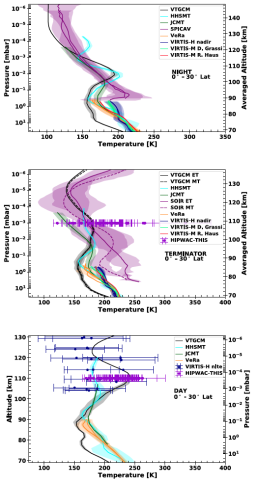
Planetary-scale Wave Impacts on the Venusian Upper Mesosphere and Lower Thermosphere
Venus’ atmosphere has a cloud layer (~40 km - ~70 km) that encompasses the whole planet that separates the lower atmosphere and upper atmosphere. Images of the clouds show planetary-scale wave patterns that exist from the equator to mid-latitudes and are thought to be a combination of Kelvin and Rossby waves.
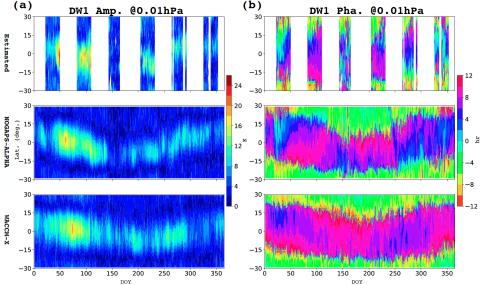
Day-to-Day Variability of Diurnal Tide in the Mesosphere and Lower Thermosphere Driven From Below
The migrating diurnal tide (DW1) is one of the dominant wave motions in the mesosphere and lower thermosphere. It plays a crucial role in neutral atmosphere and ionosphere coupling. The DW1 can vary over a range of time scales from days to years. While the long-term variability of the DW1 is mainly attributed to the source and background atmosphere variability, the driving mechanism of short-term DW1 variability is still openly debated.
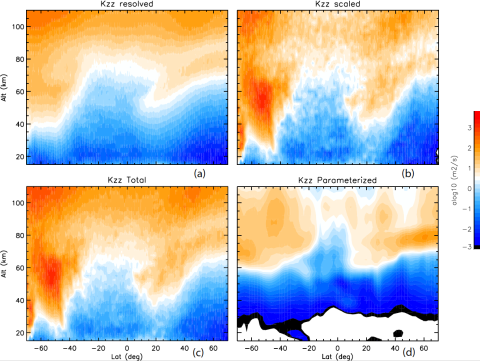
Effective vertical diffusion by atmospheric gravity waves
Han-Li Liu has observed that atmospheric gravity waves may transport heat and chemical species in the vertical direction.
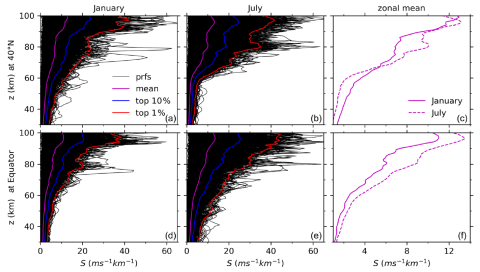
Gravity-wave-perturbed wind shears derived from SABER temperature observations
Large wind shears around the mesopause region play an important role in atmospheric neutral dynamics and ionospheric electrodynamics. Based on previous observations using sounding rockets, lidars, radars, and model simulations, large shears are mainly attributed to gravity waves (GWs) and modulated by tides (Liu, 2017).
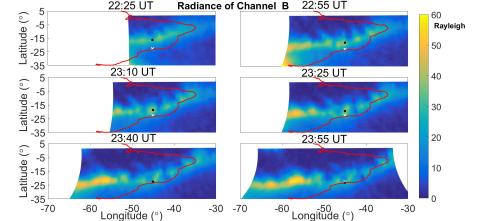
Observation of Postsunset OI 135.6 nm radiance Enhancement in South America by the Global-scale Observation of Limb and Disk (GOLD) Mission
The Global-scale Observation of Limb and Disk (GOLD) mission, for the first time, provides synoptic two-dimensional (2D) maps of OI 135.6 nm observations.

Alfvénic thermospheric upwelling in a global geospace model
First author, William Lotko, reveals that the CHAMP satellite orbiting near 400 km altitude near the magnetic cusp routinely traversed thermospheric density enhancements (up to 50%) that are not predicted by empirical models. The density enhancements are well-correlated with kilometer-scale field-aligned currents interpreted as ionospheric Alfvén resonator modes.
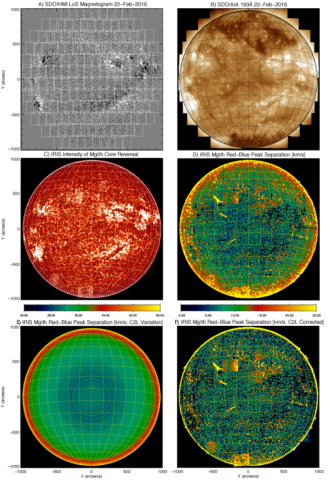
Detecting the Chromospheric Footpoints of the Solar Wind
Coronal Holes present the source of the fast solar wind. However, the fast solar wind is not unimodal—there are discrete, but subtle, compositional, velocity, and density structures that differentiate different coronal holes as well as wind streams that originate within one coronal hole. In this Letter we exploit full-disk observational “mosaics” performed by the Interface Region Imaging Spectrograph (IRIS) spacecraft to demonstrate that significant spectral contrast exists within the chromospheric plasma of coronal holes.